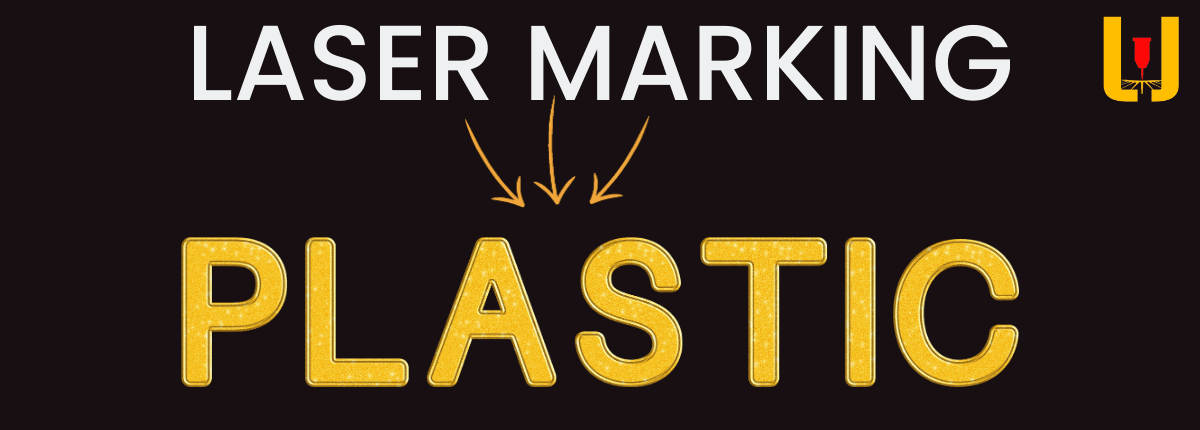Laser marking plastic is a highly efficient method for labeling plastic components and polymer parts. This non-contact optical process utilizes the energy input from a specific type of laser to mark or engrave the plastic surface. The result is permanent and legible. It uses for the identification and tracking of various products.
There are various types of plastics available in the market. Each type behaves differently when it comes under a laser beam. Few of them are laserable for marking without any use of additives or marking spray on them. But few of its types need these sprays before the marking process.
Furthermore, laser marking can mark transparent plastics. It makes it suitable for a wide range of applications. The properties of the plastic, including its absorbance and widespread use, influence the laser marking process.
This article will delve deeper into the methods and techniques involved in laser marking plastic. Mainly; focusing on its applications and the factors that influence the process. By understanding how different types of plastics and their sprays can impact the behavior of laser marking. Manufacturers can optimize the settings and parameters of the marking machine to achieve precise and reliable results.
Process Of The Laser Marking Plastic Parts
There are various methods to label plastic products with laser machines. As plastic engraving process heats the material and evaporates the surface to create deeply engraved designs. On the other hand, the plastic etching process melts the surface to produce an etched design. Engraved design is much deeper than etched design.
Now comes our topic of laser marking plastic. It is a highly efficient and precise process. It is a permanent method due to the high-power laser beam. We can mark logos, brand names, photos, and symbols to label designs on these plastic materials.
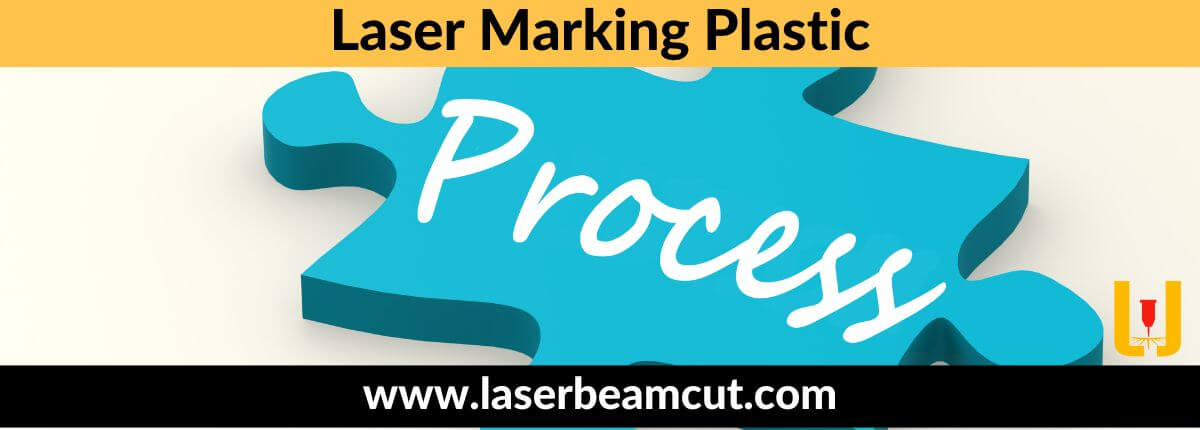
In this process, a beam heats the plastic surface and alters the material color to produce the required design. The key point is that there is no removal of any material took place.
Moreover, the heat conductivity of plastics is generally lower compared to metals. This property plays a crucial role in laser marking. It determines the heat transfer within the material during the marking process. Plastics with low heat conductivity that prevent excessive heat dissipation are better suited for laser marking.
Marking Process Affecting Parameters
It needs to consider various factors to attain the required mark results. The laser parameters, including power, speed, and focus, must be adjusted according to the specific plastic and the desired marking depth. Manufacturers can achieve precise and permanent markings on plastic parts by using optimal machine settings.
A few Parameters that affect the process are
- Laser Marking Machine
- Plastic Type
- Marking Spray
Laser Markers for Plastic Materials
Laser markers for plastics come up with various options. Mainly, these machines differ in their laser device. There are different laser-type markers available in the market. Each laser type has a unique wavelength and power.
For instance, ultraviolet or far infrared wavelengths are often employed depending on the respective material’s characteristics. This optimization allows for faster and more precise marking. It reduces the chance of heat-induced damage to the plastic.
The short-pulse laser markers produce good results. Normally, green lasers whose wavelength is 532 nm and solid state lasers of wavelength 355 nm are the best devices to mark plastic materials. But we can use devices of wavelength 1064 nm or 1030 nm to produce dark marks for special cases.
Plastic That Can Directly Marked With Laser
Some plastics can create good mark designs without using any marking spray. These types can bear highly intense beams without affecting the material properties. Such types are ABS Plastic, PC, PPSU, etc.
Plastic That Uses Additives or Marking Sprays
Few plastics can not bear machines’ high intense beams. And these give unacceptable results. To tackle this issue, we use marking sprays before the lasering process.
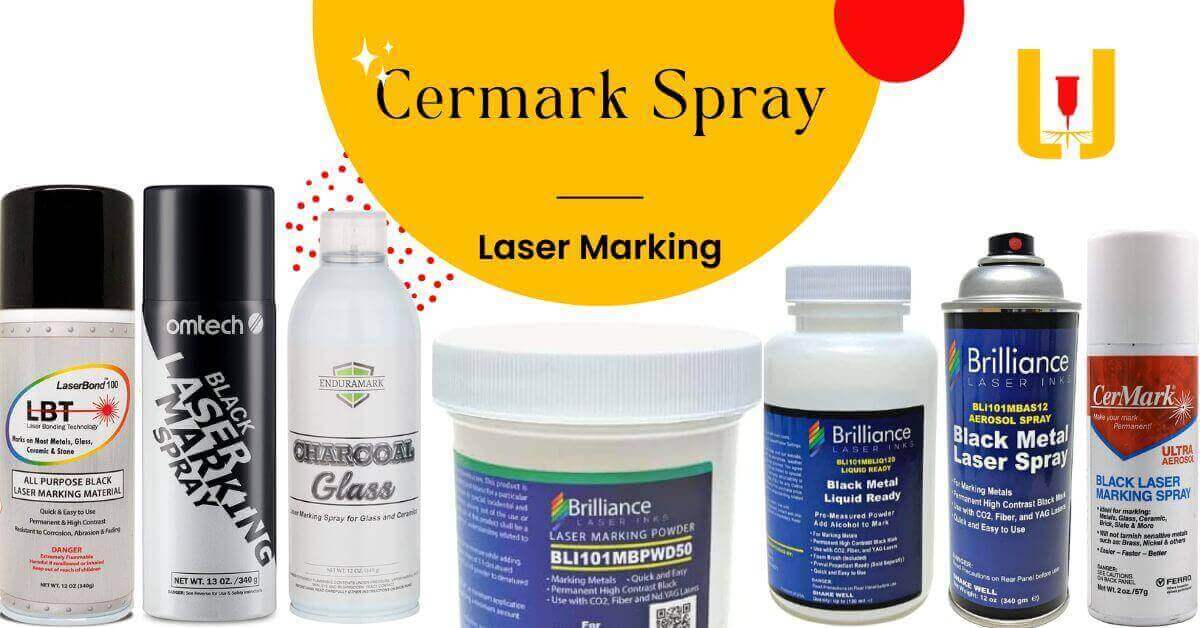
When we coat the plastic with a special marking spray or additives, It enhances the strength of the material. These marking sprays are specially designed for such materials. These marking sprays are
- Cermark
- Brilliance Laser Inks
- Liquid Ready Laser Marking Powder
Laserable Plastics for Marking Process
Plastics are versatile and widely used materials. These exhibit different behaviors when exposed to laser radiation. The ability of a plastic to absorb, transmit, or reflect laser energy depends on its macromolecular structure.
It comes in various types. Each plastic has its own set of characteristics, such as thermal conductivity, melting point, and surface tension. Therefore, it is recommended to test and optimize the laser parameters depending on the plastic type to ensure the best results.
ABS Plastic
ABS is called Acrylonitrile Butadiene Styrene. This thermoplastic is used in various industries. It offers excellent durability and impact resistance. That makes it suitable for a range of applications. When it comes to laser operations, ABS plastic presents certain limitations. Although it can be cut, or engraved using a low-power laser. But it produces harmful fumes by turning it to melting phase.
As in marking process, laser only alter the surface to produce labels on it. So, it is safe for this process. It produces acceptable results even without any additive use.
Polycarbonate (PC)
Polycarbonate is a thermoplastic material. It is widely recognized for its excellent properties. It is a possible choice for laser marking applications. With its high impact resistance and durability, it offers great potential for marking intricate designs. When it comes to laser marking, the type of laser used is crucial. And a CO2 laser with the appropriate wavelength is ideal for working with polycarbonate.
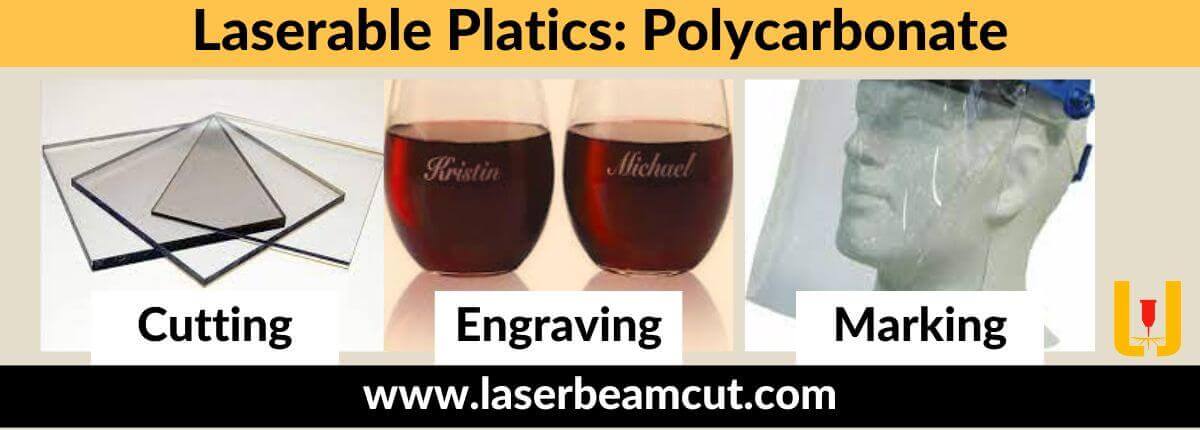
Types of polycarbonate are
- Lexan
- Lupoy
- Makrolon
These variants possess a high level of detail and exhibit good results when marked using a low-power laser. Additionally, their carbonate content ensures durable and long-lasting labels.
However, it is important to consider certain factors marking polycarbonate. Yellowish discoloring may occur during the process. It may also produce smoke during the process. To minimize these effects, precautions should be taken. Adjusting laser parameters and using appropriate ventilation systems can help these challenges.
Polycarbonate can be marked by using a fiber laser. This method yields excellent results with high levels of detail. It ensures precise and permanent markings on the material’s surface.
Delrin (POM)
Delrin is known as polyoxymethylene (POM) or polyacetals. It is a thermoplastic that belongs to the family of high-strength plastic materials. Due to rigidity and low friction properties, it is an ideal material for various applications.
When laser marking Delrin plastic, it is important to consider the laser settings and parameters to achieve the desired mark. The power, speed, and frequency of the laser should be optimized based on the specific properties of Delrin to ensure proper marking without causing melting or burning of the material.
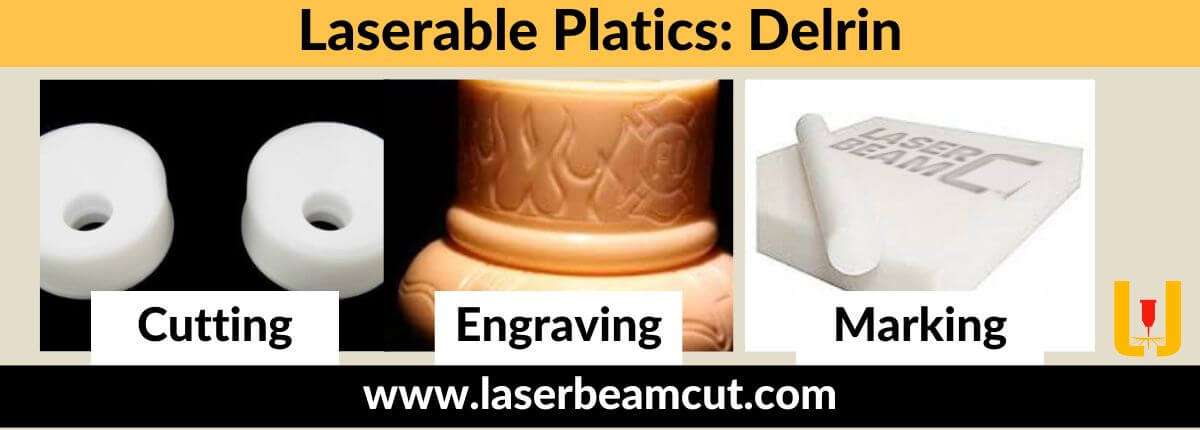
One of the advantages of using Delrin for laser marking is its excellent finishing capabilities. Due to this, it is an appealing option for engraving intricate designs and detailed patterns on various objects.
Due to their high strength properties, Delrin’s are used in bearings, pumps, and gears. It is possible to mark or engrave these products using lasers.
Mylar or polyester
Mylar is a type of polyester film. It is commonly used in laser processing applications, particularly in CO2 laser systems. Its unique properties make it an ideal material for laser cutting, marking, and engraving. The CO2 laser, with its specific wavelength, is well-suited for working with Mylar.
The focused laser beam effortlessly slices through the material. It produces clean cuts and accurate edges. This process is especially useful for creating intricate designs and complex shapes on Mylar surfaces.
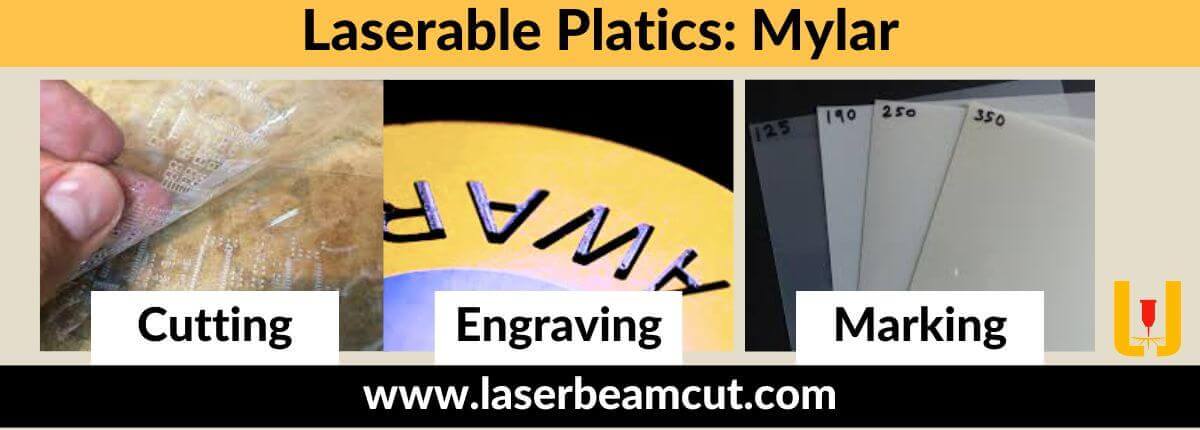
When Mylar is marked or engraved using a CO2 laser, it undergoes a surface transformation. The laser beam interacts with the material, altering its appearance and leaving a permanent mark. The result is a high-quality and professional finish that enhances the visual appeal of Mylar products.One of the key advantages of using Mylar in laser processing is its exceptional structural integrity. Despite its thinness, Mylar exhibits high tensile strength. It enables it to withstand the laser cutting process without tearing or distorting. This attribute ensures that the final product maintains its shape and durability.
Polyimide
Polyimides, such as Kapton, are a class of thermosetting polymers. These have various industrial applications due to their exceptional properties. These have high chemical resistance properties. It ensures material integrity during the laser process.
Polyamide plastics can be marked using lasers by utilizing a process called laser ablation. In laser ablation, the high-intensity laser beam removes a thin layer of material from the surface, resulting in a contrasting mark. The specific settings and parameters used for laser marking polyamide will depend on factors such as the type of laser system, power, wavelength, and desired mark quality.
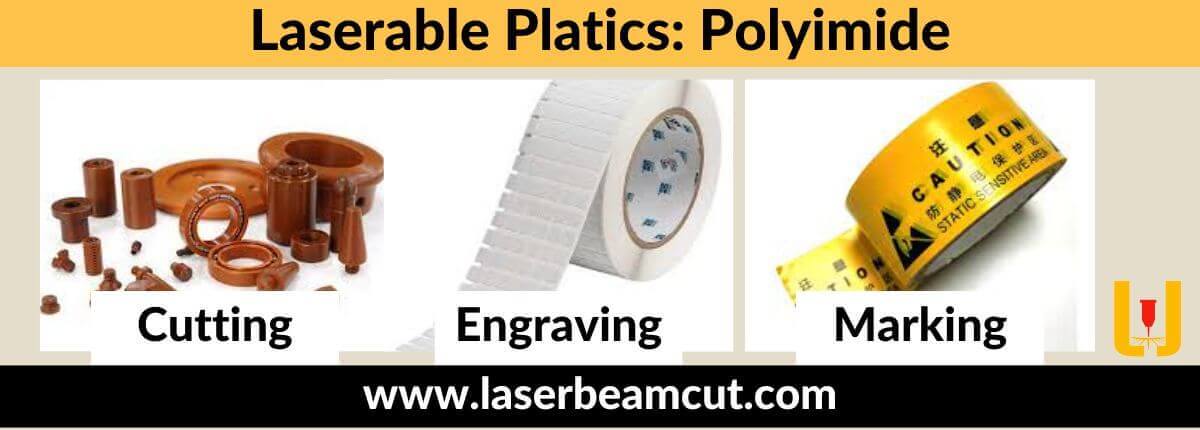
Polyimides are excellent electrical-resistant plastics. Polyimides offer good mechanical properties for numerous marking applications.
Acrylic
Acrylic is a thermoplastic material. It uses in various industries. And it can not be laser marked with direct process. You can mark it by using special marking sprays before the process.
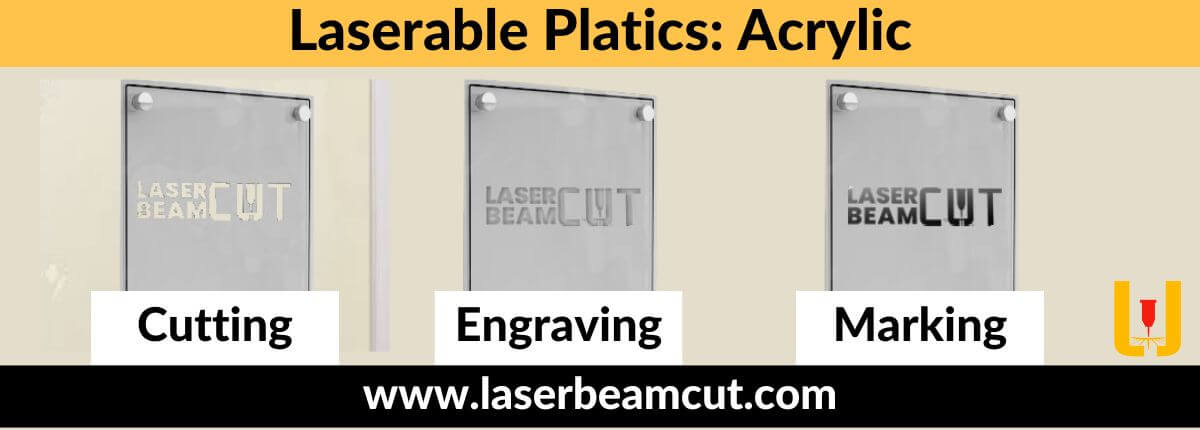
There are two common types of acrylic plastics.
- Cast Acrylic
- Extruded Acrylic
Plastic Types that Can Not be Laser Marked
Fluoropolymers (PTFE)
Fluoropolymers (PTFE) are plastics that exhibit unique properties due to the carbon and fluoride bonding within their molecular structure. These materials are highly suitable for laser engraving applications but not for laser marking.
There are various further types of fluoropolymers.
- Teflon
- Kel-F
- Halar
PVC
Polyvinyl chloride (PVC), a widely utilized thermoplastic material. It holds a prominent position among the various industries. It plays a crucial role in sectors such as healthcare, electronics, and plumbing, offering immense benefits. The inherent strength and remarkable versatility of PVC make it highly suitable for various applications that find their way into our daily lives. PVC finds extensive utilization in the manufacturing of essential items like pipes, wire insulation, blood storage bags, flooring, and synthetic leathers.
When it comes to laser marking, PVC with a high vinyl content can pose certain challenges and risks. The process of laser mark PVC can generate harmful fumes due to the presence of chlorine in the material. That can be damaging if inhaled. Therefore, it is essential to handle PVC and laser equipment with caution to avoid potential health hazards.
Types of Laser Marking for Plastics
Color Change
The color change is a captivating phenomenon that can be achieved through laser marking on various plastic surfaces. Laser marking utilizes the energy of a laser beam to selectively modify the color pigments present in plastics. This process involves breaking down the individual molecules of color pigments using the precise control of laser beam energy.
Plastics undergo different types of color change during laser marking. Discoloration occurs when the original color of the plastic is altered.
By adjusting the laser beam parameters, such as energy and duration, the color change can be tailored to meet specific requirements. This allows for the transformation of light-colored plastics into vibrant and visually appealing products.
Bleaching is another effect achieved through laser marking. This technique reduces the intensity of the original color, creating a faded or pastel appearance on the plastic surface. By carefully adjusting the laser energy, the color pigments are broken down in a controlled manner, resulting in a smooth and uniform color change.
Carbonization is a remarkable outcome of laser marking on carbon-containing plastics. This process involves controlled burning, where the laser energy induces the formation of carbon deposits on the surface. The result is dark and distinct markings that contrast beautifully with the surrounding material. The laser beam’s energy is harnessed to selectively burn the plastic, ensuring precise color change without compromising the overall structure.
Laser marking is a highly versatile process that can be applied to different plastic surfaces. It is typically used on light-colored plastics, where the laser energy can be finely tuned to achieve the desired color change without causing damage. The laser selectively breaks down the color molecules on the plastic surface, allowing for smooth and controlled transformations.
Ablation
Ablation is a widely used technique in laser marking for plastics. It offers precise and high-quality results. Various types of plastics, including multi-layer plastics and coated plastics, can undergo laser marking to achieve clear and lasting markings. The process involves selectively removing a thin top layer of the plastic, revealing the contrast between the base material and the base coating.
Coatings on plastics often consist of special layers that are designed to enhance the laser marking process. These coatings enable the laser to interact with the plastic surface more effectively. This gives an improved contrast and color in the laser-marked designs. Laser marking films are also employed to ensure a homogeneous and uniform appearance of the markings.
In applications such as buttons for vehicle interiors, symbols, and other backlit elements, laser marking is particularly advantageous. The laser’s exceptional precision and consistent pulse-to-pulse stability enable the creation of intricate and highly detailed markings. That maintains excellent visibility in both daylight and nighttime environments.
One of the key steps in the laser marking process is layer ablation. By selectively ablating the thin top layer of the plastic, the laser removes unwanted material and reveals the desired markings. This controlled ablation ensures that the underlying layers remain intact and undamaged, resulting in a high-quality and long-lasting marking on the plastic surface.
Foaming
Foaming is a fascinating process that involves the generation of gas bubbles within a matrix material, resulting in a lightweight and porous structure. This technique finds its application in various industries. It includes the field of laser marking for plastics. Laser marking, one of the surface-altering processes, selectively melts the plastic surface to create distinct markings.
During the foaming process, laser energy is directed toward the plastics, causing localized melting. The trapped gas bubbles within the matrix material expand as a result of the heat. It leads to the formation of raised markings on the surface. These raised markings can be easily identified and visually appealing. Especially, when contrasting against the surrounding plastic.
One interesting aspect of laser marking on plastics is the use of different colors. Dark plastics, such as black, tend to absorb laser light more efficiently, resulting in a marking with a darker appearance. On the other hand, bright colors diffuse the laser light, causing a less pronounced marking.
The cooling stage is crucial in the foaming process as it allows the melted plastic to solidify and stabilize the gas bubbles. Effective cooling ensures that the raised markings maintain their shape and durability. By controlling the cooling rate, manufacturers can achieve desired characteristics in the final product, including the clarity and legibility of the laser markings.
The combination of foaming and laser marking techniques offers numerous advantages for industries working with plastics. The lightweight and porous nature of the foamed structure enhances the overall product performance. While the laser markings provide clear identification and branding.
Why Choose Laser Marking To Mark Plastic Materials?
Laser marking offers a compelling choice for labeling plastic products due to its numerous advantages. While alternative methods exist, laser marking provides a range of factors that make it a preferred option for marking plastics.
Flexibility
Laser marking offers a flexible solution. It allows for precise adjustments of parameters such as wavelengths and powers. This flexibility enables customization to meet specific marking requirements, ensuring optimal results.
Gentle Process
Laser marking is a non-contact process that does not involve physical contact with the plastic material. This gentle approach prevents any damage or distortion. It preserves the integrity of the material while achieving accurate and high-quality markings.
High Quality
Laser marking delivers exceptional quality results on plastic materials. The precise control over parameters ensures clear, legible, and durable markings. This high level of quality is essential for applications where readability and longevity are critical.
Applications Of Laserable Marked Plastics
The applications of laser marking on plastic materials are extensive and diverse. Here are some notable examples:
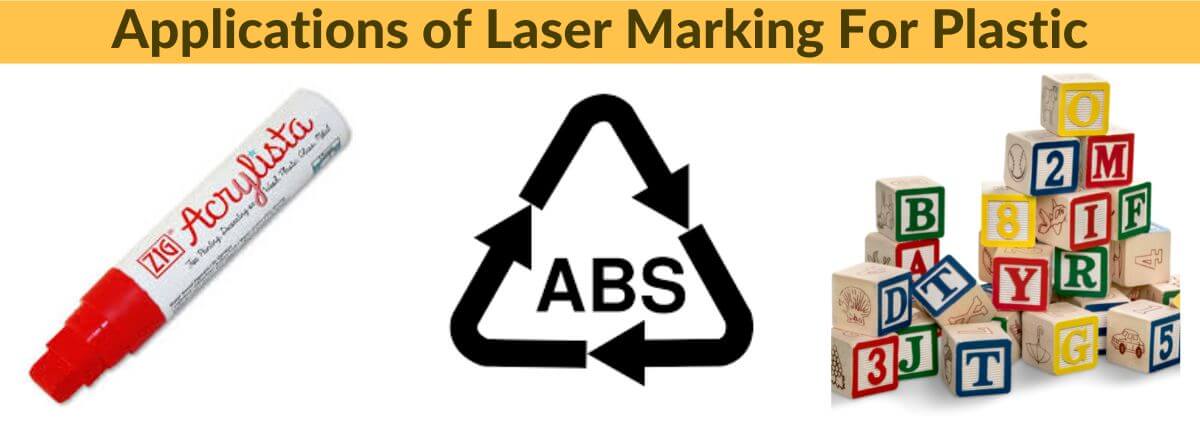
Product Identification
Laser marking is widely used for product identification purposes on plastic materials. It allows for the precise and permanent marking of product names, serial numbers, barcodes, and logos. This enables efficient tracking, traceability, and anti-counterfeiting measures.
Consumer Electronics
It is commonly employed in the consumer electronics industry for marking plastic components such as keyboards, keypads, and device housings. It provides clear and durable markings, enhancing product aesthetics and brand recognition.
Medical Devices
Laser marking is crucial in the medical device industry for marking plastic components like surgical instruments, implants, and medical equipment. It ensures accurate and permanent identification. It assists in device tracking, sterilization, and regulatory compliance.
Automotive and Aerospace
It is utilized extensively in the automotive and aerospace sectors for marking plastic parts, such as dashboards, instrument panels, switches, and interior components. Laser marking provides durability, resistance to wear, and compliance with industry standards.
Packaging and Labeling
This is employed in the packaging and labeling industry for marking plastic packaging materials, such as bottles, containers, and films. It enables the inclusion of product information, expiration dates, batch codes, and branding, ensuring readability and durability throughout the product’s lifespan.
Promotional Items and Gifts
It is commonly used to personalize plastic promotional items and gifts. It allows for the customization of items like pens, keychains, phone cases, and awards, adding a personal touch and enhancing their value.
Electrical and Electronics
Laser marking finds applications in the electrical and electronics industry for marking plastic components, including circuit boards, connectors, and cable insulation. Laser markings assist in identification, assembly, and maintenance processes.
Signage and Displays
It is employed in the signage and displays industry for marking plastic materials like acrylic, polycarbonate, and PVC.
It enables the creation of intricate designs, precise texts, and detailed graphics on plaques, nameplates, and architectural signage.
Future of Laser Marking for Plastic
The future of laser marking plastic is promising and bright. Laser marking is increasingly popular due to its high precision and versatility. The demand for laser marking on plastic components is expected to grow significantly, especially in the medical, automotive, and consumer electronics industries.
Advancements in laser technology will make the process faster and more cost-effective. It enables its use for mass production. Moreover, the rise of AI (Artificial Intelligence) and IOT (Internet of Things) will change the manufacturing and designing industries. Machines will take decisions on our past experiences and produce the exact outputs that we need. Overall, laser marking plastic holds a prosperous future with expanding applications and enhanced capabilities.
Summary
Laser marking plastic is an efficient and precise method of labeling plastic products. It uses a specific type of laser to mark the plastic surface. It gives permanent and legible markings.
Different types of plastics behave differently under the laser beam, with some requiring marking sprays or additives. Factors such as plastic-type, laser parameters, and marking sprays affect the marking process.
Laser markers with various laser types and wavelengths are available for different plastic materials. Laser marking can achieve color change, ablation, and foaming effects, providing flexibility and high-quality results.
FAQs (Frequently Asked Questions)
1. What is Thermosetting Plastic?
Ans: Thermosetting plastic is a type of polymer that, once cured, cannot be melted or reshaped by heat. It uses in applications that require high heat resistance, rigidity, & durability.
2. What is PP Material?
Ans: PP (Polypropylene) is a thermoplastic polymer. It is lightweight, durable, and resistant to chemicals, moisture, and high temperatures. PP material uses in consumer goods, packaging, and textiles.
3. What is Delrin?
Ans: Delrin is a brand of polyoxymethylene (POM), a thermoplastic material known for its high stiffness, low friction, and good dimensional stability.
4. What chemicals are used to make plastic?
Ans: Several polymers use in the production of plastics, including ethylene, propylene, benzene, and toluene. Manufacturers also use pigments, stabilizers, and fillers as additives.

